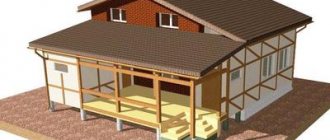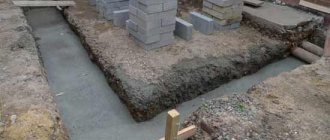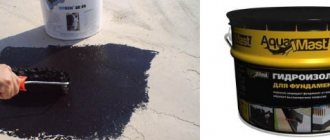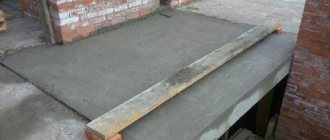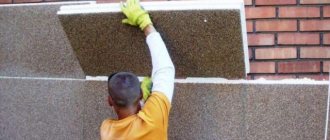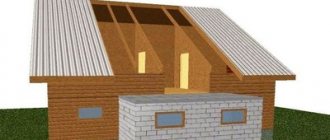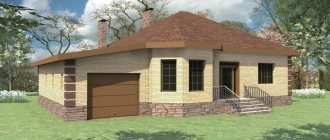Due to lack of budgetary funds or time, often the built property does not correspond to the desired area. And then the owner begins to plan its expansion to the required size. This is achieved by constructing various types of extensions: living rooms, garage, veranda, terrace and others. The main task is to figure out how to connect two foundations to each other in order to obtain a complete structure that will become the basis of a strong and durable house.
Difficulty connecting bases
There may be several answers to the question of how to properly build a foundation, since the choice of specific solutions directly depends on the house itself. If you are going to add an extension to a building you just built with your own hands, the foundation connection will be different than when adding an extension to an old house. Let's look at the main options for connections:
- If the building was built a long time ago, it had time to go through all the stages of shrinkage and firmly took its place in the ground. In this case, it is most appropriate to connect an extension with a strip or slab base using a rigid coupling - a connection based on a common reinforcement frame.
It is created by drilling holes in concrete and inserting reinforcing bars into them. This solution is not used very often, since it is only suitable for non-heaving soils with high bearing capacity.
If the house has just been completed, and the shrinkage processes will continue for several more years, it will be necessary to build a new independent foundation with an expansion joint. It will allow you to connect the two parts of the building, but at the same time provide compensation for any impacts during shrinkage. The expansion joint also serves as a heat insulator, further protecting the lower part of the house from the penetration of cold.
The second option is most often used on heaving soils, where it is difficult to predict how shrinkage will occur and what effect it will have on the foundation of the house. Building an extension with an expansion joint means protecting it from cracks in the foundation, and it can last for a very long time.
Rigid method of connecting foundations
If you have purchased an old house, it is advisable to ask the previous owners in as much detail as possible in advance about all the features and time of construction of the house. The most difficult thing is when the building was built a very long time ago, and during its service it managed to change several owners. It will be difficult to find information about when major foundation repairs were performed and what type of foundation was used for this structure.
To ensure a strong connection between the old foundation and the new one, you need to do the following:
- Holes are drilled in the old foundation at the rate of 20 pieces per square meter. The diameter of the holes should be several millimeters greater than the diameter of the reinforcement, and the depth of the holes is calculated using the formula: the diameter of the reinforcing bar must be multiplied by 35. As a result, the foundation will be prepared for laying new reinforcement.
- A pit is dug under the new foundation, after which a thick sand “cushion” is poured into it - a compacted layer that increases the bearing capacity of the foundation. Formwork is installed along the edges of the pit, after which the reinforcement cage can be laid.
The reinforcing pins are connected to each other with a special knitting wire. It is not advisable to use welding, since the places where the metal rods are fastened will be vulnerable to corrosion.
The prepared frame and formwork are poured with concrete. It is important that the layer is solid; there should be no air voids in it. The space between the reinforcement must be pierced with a stick in several places; the solution can also be compacted using a vibrator.
The dried base will be completely monolithic and firmly connected to the old foundation of the house. Such an extension will receive reliable support, and any changes in its foundation will be reflected in the foundation of the house. A single basis is a reliable, although quite labor-intensive, choice.
Construction errors and reviews
In the conditions of Russian regions, soil heaving can become a real problem . In frosty winters, in some places heaving forces can reach 100 tons per 100 m2 of base area.
Often during the construction of a pile-grillage foundation this circumstance is neglected, which leads to inevitable destruction and deformation. To prevent this from happening, leave a gap between the grillage and the ground level (5 - 7 cm), which is then covered with a blind area.
If construction was carried out with a buried belt without analyzing the soil for heaving forces, then it is necessary to carry out calculations as early as possible and, if necessary, organize compensation measures. To reduce the impact of heaving soils and reduce heat loss at home, the walls of the tape are insulated and extruded polystyrene foam is placed under the blind area.
Errors during calculations can lead to deformation of the walls of the structure and/or subsidence . Most often this happens due to conventionally taken freezing points, the depth of groundwater, and the total load on the soil through the base.
You can read about special cases of construction of the presented type of foundation on the forums - here, here and here. Users have already encountered the consequences of incorrect calculations and are considering ways to solve the problem.
Foundation with expansion joint
An extension to a house with a foundation with an expansion joint is most often used in industrial and multi-story construction. That is, where the soils under the structure can differ significantly in their deformation properties. For example, quite often an extension of another number of storeys is connected to an existing house of one storey by laying a foundation with an expansion joint. In any case, an expansion joint must be provided at the construction design stage.
At its core, any expansion joint, through which a foundation for another building is connected to a house, is insulation in the gap between the basement floors and the walls. Often, ordinary tow is used as this insulation. The place where the connection to the house is made is fenced off with a special decorative overlay, which is attached to the house wall.
When building a house on heaving soil, experts recommend making the floor level of the extension lower than the floor level of the main structure. The magnitude of the difference must correspond to the expected deformation.
To attach a foundation to an existing house using an expansion joint, the following significant points should be taken into account:
- Leave a small gap between the main house and the foundation of the extension (no more than 5 cm). In order to comply with this requirement, before starting to lay the foundation, you should attach boards pre-treated with waterproofing material to the foundation of the house. In the future, it is they who will perform the function of an expansion joint assigned to them.
- In single-story construction, the thickness of the expansion joint can be no more than 2 cm.
- If desired, the expansion joint can be filled with any heat-insulating material. Most often, penoplex and polystyrene foam are used for this purpose. From the outside, everything is covered with a decorative overlay.
If we are talking about a small extension, it can be built on a shallow strip foundation or a foundation on stilts.
Waterproofing and insulation of pile-strip foundation
Screw piles located in the ground do not need to be insulated in any way. The tape part of the base, including those located below the zero level, is subject to thermal insulation. Any materials with a high moisture resistance can be used as thermal insulation: polystyrene foam, extruded polystyrene foam, sprayed polyurethane foam. If you have the financial opportunity, it is better to choose polyurethane foam sprayed thermal insulation, which creates a single layer of insulation without joints or seams. Thermal insulation of monolithic tape is recommended to be done inside and outside.
Before attaching the insulation boards, the surface must be cleaned and covered with waterproofing mastic. The insulation is attached using dowel-nails. A reinforcing fine mesh is installed on top and a layer of plaster or other facing material is applied.
To protect the pile-tape foundation, it is necessary to arrange a blind area. It is performed immediately after insulation before filling the buried part with soil. If necessary, drainage can be made under the blind area to remove excess moisture from the building.
You can ask your question to our author:
Features of connecting foundations
The most important thing that is important for the homeowner to take into account is that the foundation of the attached structure must correspond to the foundation of the main building. Savings are not appropriate here
It is not recommended to place an extension on poles if the house itself is on a reinforced concrete strip. In addition, when designing a new foundation, it is important to respect the width of the strip base or the dimensions and depth of the pillars in the ranges of the previously built house.
The reason that the foundations of buildings should be the same is their different interaction with soils and, accordingly, differences in shrinkage. To avoid the occurrence of cracks and other violations of the integrity of the structure, do not neglect this rule. Maintaining identical foundation depths will help avoid distortions of buildings.
Installation cost
The choice of foundation is based on the type of soil and economic feasibility . The cost of a strip base will take from 20 to 40% of the construction cost. Installing piles will be much cheaper, but this choice does not always correspond to the conditions of the project.
Therefore, most builders choose an alternative method - installing a pile foundation combined with a grillage. The price for turnkey construction will be optimal and in Russian regions will be approximately 3,400 - 4,000 rubles per m2.
You can find out how much it costs to build a pile-strip foundation from this article.
Foundation of an extension to a brick house
In the case of a brick suburban building, in most cases, a strip reinforced concrete foundation is chosen for the extension. In the field of private country house construction, a monolithic version of the foundation is sometimes used. This is partly due to the fact that almost everything can be done independently, without hiring third-party specialists.
Work on laying the foundation for an extension to a brick suburban building is carried out in the following order:
The first step is to level the site intended for the foundation.
Next, marking is done, with special attention paid to right angles. All markings are performed using the most standard mathematical and geometric calculations, using available tools. Upon completion of site marking, excavation work is carried out
Here it should be taken into account that the foundation of the extension must be deepened below the freezing level of the soil. Then trenches are made for pouring the strip concrete base. Along the bottom of the resulting trenches, using crushed stone or sand (often both materials are combined), a cushion is made, the thickness of which should be determined in accordance with the soil conditions of the area. As a rule, the thickness of the crushed stone or sand cushion does not exceed 15-20 cm. Next, work is carried out to create a rigid connection to the existing foundation of a country house, or conditions are prepared for creating an expansion joint. Regardless of the size and weight of the extension to the house, it is strongly recommended to reinforce the foundation structure. For this purpose, reinforcing rods or ready-made reinforcement mesh are used. After this, it is necessary to make wooden formwork. It can only be placed on those areas of the future foundation that will be located above the ground level. To fill the foundation, it is recommended to use a high-quality cement mixture that was prepared in accordance with the manufacturer's instructions. Experts advise choosing a grade of cement not lower than M400, which will allow you to obtain the necessary strength characteristics. In the process of pouring cement mortar, it needs to be compacted, doing this with the usual cutting of reinforcement. Of course, compacting cement mortar most effectively can be done using an internal vibrator, but not everyone has such a tool (it can be rented from construction companies). If work on the installation of a foundation structure is carried out in the summer, then it would be correct to pour water on the cement mortar 3-4 times while it hardens, which will eliminate the possibility of cracking of the base during the process of gaining strength.
It must be remembered that the optimal time for the cement mortar to harden and acquire all the necessary strength characteristics is 3 - 4 weeks.
Types of foundations for replacement
The old foundation under a wooden house is destroyed under the influence of high humidity and climatic conditions. Homeowners believe that it is not possible to replace rotten beams without dismantling the roof and walls of the log house. Rolling a house over a log in order to replace parts lying at the base of the structure is not economically profitable and takes a long time. It is not necessary to carry out complete dismantling for this; there are reconstruction methods that allow repair work to be carried out without the involvement of construction crews and special equipment.
There are several ways to pour a foundation for a finished wooden house:
- Strip foundation - laid out with ready-made concrete blocks or poured under the walls of the building. Such a foundation evenly distributes the weight of the house and can be built on soil of any density.
- The columnar structure is suitable when the house has small dimensions and weight.
This base is easy to build. The base is installed on pillars driven vertically into the soil. The strength of the structure is ensured by special concrete beams.
- Pile foundations are used on uneven terrain and close proximity to groundwater.
The length and cross-section of the pile can be any.
- Monolithic slab - placed under the house when it is built on swampy soil.
The formwork is installed around the perimeter of the building, and the entire area under the house is poured. The result is a secure foundation. This type of foundation is more expensive than others.
Monolithic bases can be mounted from ready-made iron-concrete slabs. Several reinforced concrete products are pushed from different sides one by one. The joining place is filled with concrete solution.
After examining the old foundation, it became clear that it urgently needed to be reconstructed. It remains to figure out how to add a foundation to an old wooden house without raising the house. Actions begin with determining the appropriate type of base.
This is done before dismantling the rotten logs and lifting the wooden house onto the foundation, since in each case different technology is used.
Pros and cons of recovery
Using screw piles for foundation repairs has the following advantages::
- The ability to perform all actions using the most gentle methods possible.
- Simplicity and high speed of operation.
- In some cases, all actions can be performed manually, without the use of special equipment.
There are some disadvantages:
- The bearing capacity of screw piles is limited and requires high-quality calculations.
- The installation of piles is carried out in rather difficult conditions, which reduces its quality.
- Creating a full-fledged foundation under an existing building is a complex engineering task that cannot be entrusted to just anyone.
In addition to these features, it should be taken into account that screw piles are immersed before contacting dense layers.
If this does not happen, no professional will vouch for the performance of the support, which creates a significant problem and requires preliminary clarification .
Foundation with rigid connection of bases
Most often, a rigid connection between the foundation of the main building and the extension is used on soils that are not subject to heaving. Most often, this method is used in the process of low-rise construction in situations where the extension is functionally connected to an existing building and is located with it under a single roof.
To make a base for an extension, a special hole is drilled in it to a depth of about 35 cm. Its diameter should be equal to the diameter of the reinforcement that will be used for driving. If the construction of an extension is carried out according to a scheme that assumes the estimated length of the reinforcement is greater than the width of the foundation, holes in the base of an existing house are drilled only part of the width. The reinforcement is installed using the anchor principle.
A rigid connection is also used in situations where the house has a recessed strip base, and the construction of the extension is planned from monolithic reinforced concrete.
A foundation with a rigid base can be available in two versions:
When installing such a foundation, the following list of works is expected to be performed:
- dig a trench, the depth of which corresponds to the existing foundation of the main building;
- fill the bottom of the trench with sand (create a sand cushion) and compact it;
- drill holes in the base;
- drive reinforcing bars with a longitudinal slot into pre-prepared holes;
- insert a wedging liner (for example, made of wood) into the reinforcement slot;
- drive the reinforcement into the holes in the corners of the base;
- form the frame using the remaining extract from the reinforcement that has already been driven in (for this purpose, parts with a length of 300 to 400 mm are specially left;
- after making the frame, fill the base tape with concrete;
- wait for the concrete to dry completely.
In order to attach a foundation to a house, you will need a whole list of equipment. First of all, we are talking about the following tools: a shovel, a building level, reinforcing bars, sand, wood inserts, a mixture of concrete and boards for making formwork.
The algorithm for constructing a combined foundation is as follows:
Site preparation
The area must be cleared of debris, leveled if possible, and the top layer of soil and vegetation removed. Next, markings are made using a tape measure and a building level, the places where the supports are screwed in and the location of the foundation tape are determined. Holes for piles with a depth of 20-30 cm are prepared. A trench of the same depth is dug to deepen the future foundation. It is recommended to sprinkle the bottom of the trench with coarse sand to reduce heaving.
Foundation
A correctly chosen foundation ensures the reliability of the entire building. When laying it, the materials, the planned load and the nature of the soil are taken into account. Sheds or light summer structures can do without a foundation.
There are several types of base: screw, monolithic, columnar, tape. Any base must be waterproofed.
Let's consider the last two options as the most common.
Tape
A massive building made of heavy materials requires a solid foundation. This is what a strip foundation is. It is a closed strip of various materials passing under the load-bearing walls of the housing.
Why does deformation occur?
Deformation during foundation shrinkage
Different foundations behave differently when in contact with soils susceptible to heaving. Therefore, if the base is strip, then the new one should be the same
Another important rule: you cannot lower the new foundation below the main one.
How to determine the width of the sole of the strip base:
- You need to take a metal rod, the end of which is bent at a right angle.
- We push the rod under the structure so that the hook is positioned horizontally.
- After the rod passes the base, we unfold it so that the hook is positioned vertically, with the tip up.
- Pull the rod towards you until it stops.
- Let's make a mark.
- Unfold and pull out the rod.
- The segment from the mark to the fold is equal to the width of the sole.
Reasons for shrinkage of the extension:
- The main building has usually already settled down, but the new extension is just beginning to sink.
- Part of the attached foundation rests on imported soil, and part on “native” soil. This leads to complex deformation displacements, causing the formation of cracks in the most unpredictable places.
The consequences of natural shrinkage can be minimized by extending the construction period. To do this, we allow the foundation to stand for at least one season. The extra weight will cause some shrinkage, but not as much.
Complete replacement or restoration: what determines the choice
Work with the old foundation begins with an analysis of its type and assessment of its condition. There are three options for structures erected previously for the installation of wooden log houses.
Columnar. They were mainly made of red brick, which is not resistant to moisture. The masonry quickly collapses, the building erected on it sags and warps. In such cases, the lower crown often rots, which must be changed simultaneously with the restoration of the base.
Columnar supports cannot be restored; they have to be replaced with piles, or a strip foundation must be placed under the house.
Chairs (wooden decks). These types of bases were used in many regions. The columns were made of oak: it is strong, but not eternal, so over time it completely rots. Wooden posts need to be replaced.
Tape. On such a base, cracks, destruction of corners, and chipping of individual areas often form. After assessing the condition and monitoring the rate of crack expansion, the foundation can be strengthened by adding cement mortar.
Watch the video:
If the percentage of destruction is large, or the cracks are increasing at a high rate, and the building is warped, it is also advisable to completely replace the strip base.
Preliminary work
Work begins with an assessment of the general condition of the existing foundation. They dig a trench about 50 cm wide around the perimeter of the building.
The foundation is cleaned of adhering dirt, the condition is assessed, and a suitable restoration method and materials are selected. An estimate is drawn up, which includes the labor of workers, the cost of materials and the use of lifting equipment. The technology is not always used because it requires costs and convenient access to the building. Prepare in advance:
- Jacks (from 4 pcs.), capable of lifting loads from 10 tons;
- Jackhammer, sledgehammer and crowbar;
- Wedges;
- Temporary supports (beams, bricks, boards for the house and jacks);
- Concrete mixer;
- Reinforcement with a thickness of 12 mm;
- Crushed stone, cement and sand (for making concrete);
- Waterproofing.
Dismantling technology
The dismantling technology depends on the type of piles and the material from which they are made. Driven concrete piles are cut with a diamond tool and destroyed with jackhammers .
In difficult cases, they are pulled out using lifting equipment, firmly secured to cables.
All these actions constitute a time-consuming and demanding engineering task that requires the participation of experienced specialists and heavy equipment.
Dismantling screw piles is much easier. The strapping is dismantled and the piles are separated from each other.
Then they are unscrewed from the ground manually or using special mechanisms.
It is noteworthy that the piles can then be used again in another place.
Ideal option for connecting foundations
Already at the stage of building a house, you should think about the fact that after a certain time you will want to expand your home possessions.
It is much easier to lay the foundation for an extension at this stage. This is the ideal foundation technology. This approach will allow you to create a rigid structure, and you will not have to think about expansion joints and other design solutions.
You can cover the area that is empty in the meantime with decking - temporary structures. This approach will do nothing to a well-waterproofed foundation. In addition, during this time the base will take the strongest position and reduce the risk of settlement during the construction of the above-ground part of the extension.
Thus, a situation often arises when an extension or a new building needs to be erected next to the house.
When attaching a new foundation to an old one, it is necessary to give the new part time to harden well. Ideally, at least a year should pass from the stage of designing the foundation and laying it to erecting the walls.
In this case, it is necessary to take into account such factors as the topography of the site, the type of soil, the weight of the building and other features
How to add a foundation to an old building yourself
- Why is it necessary to strengthen the foundationGeneral recommendationsStrengthening the foundation of a house on columnsOrganization of ventilation
If you become the owner of an old house, then sooner or later you will have a desire to expand its living space and you will be interested in the question of how to add foundation.
If your house has an old and poor foundation, then the solution is to attach a new foundation to the old one.
In order to increase the area of the house, there are two options: you can expand the house to the sides, but this is not always allowed by the yard area, or build it up. When choosing the latter method, it is necessary to strengthen the foundation of the house and for this you will have to add foundation.
Separate supports
If there is a large discrepancy in the weight of the old and new structures, the degree of shrinkage of these structures will differ significantly in magnitude. In such cases, it is not recommended to make a rigid connection for the foundations - it is necessary to choose separate construction of the supporting elements. It is possible to attach other types of foundation to the existing foundation and to do this use the principle of connection through an expansion joint.
The weight of the ceilings and walls of the extension should be distributed over its own support area, without creating tearing forces for the main foundation of the building.
Depending on the operating conditions, the expansion joint can be:
The sedimentary option (in the absence of other significant influences) has a width of 1 - 2 cm. According to the conditions of the mutual influence of the supports, attachment to the load-bearing wall of an old house can be carried out with a deformation gap reaching 0.2 - 0.4 m, filled with elastic, moisture-proof material.
Piles can be placed next to the house
Frame wooden extensions are successfully operated on a pile foundation with a metal grillage, as in this photo.
Light verandas or summer kitchens can be built on screw piles, even if there are already several nearby buildings around. This is especially convenient if the site is located on a slope, slope or with uneven occurrence of hard supporting rocks.
At the design stage, the external design of expansion joints that visually separate the facade is envisaged, in an open or hidden form, for example, hiding the gap under a vertical drainpipe. On the façade side, they are usually covered with strips of a special flashing and sealed with low-strength decorative material, which will not prevent the outer walls of buildings from moving relative to each other with possible uneven settlement. Under the roof deck, gaps are bridged using a compensation device.
An extension to a house, installed on separate supports, is a much less labor-intensive process than installing a rigid link, requires significantly less time and financial costs, and can also be done with your own hands without ordering special equipment
A far-sighted solution is to provide for the possibility of an extension at the design stage of the main building of a private house. This will greatly simplify subsequent work and will contain ready-made design solutions, planned uniform settlement over the entire area of the foundation and will ensure the reliability of the foundation.
Beginning of work
Before starting excavation work, complete a set of preliminary measures:
Development of a sketch of a future building, carried out at the initial stage of work. When sketching, analyze the presence of communications running under the construction site and the depth of its location. This will avoid conflict situations with the owners of neighboring plots and utility organizations. Calculation of the mass of the future garage, allowing you to determine the type of foundation. Using a preliminary drawing with dimensions and calculation results, the need for building materials is determined and the level of costs is assessed. Selecting a construction site
It is not enough to just determine the location of the building; it is important to examine the soil characteristics and begin digging trenches after completing geological studies. Soil exploration will allow you to determine the level of groundwater and make a decision on the depth of the trench
Pouring the foundation for a garage with your own hands is done after sampling at the construction site and analyzing the samples. Remember that with high soil moisture, drainage is necessary. After all, the freezing of water in the soil causes deformation of the base, and in the future can cause cracks to appear. Marking the site using rope and pegs. This is the final stage, allowing you to accurately record the boundaries of the building. The exact outline of the building will allow you to properly prepare and concrete the area for the garage.
Causes of destruction
Foundation failure occurs for a number of reasons.:
- Design errors.
- Errors during construction, use of low-quality materials.
- Changes in the hydrogeology of a site caused by external causes.
- The appearance of additional load, extensions, new floors, etc.
- Construction work near the house caused changes in the structure of the soil.
- Poor quality waterproofing, which allowed concrete structures to become saturated with water.
The causes of destruction can appear either individually or several at a time, which sometimes complicates their localization and the choice of elimination method. Typically, the criteria for assessing the causes of destruction are the shape and volume of deformations, the type of cracks and other visible signs .
IMPORTANT!
Correct determination of the causes of destruction allows you to choose the optimal solution to the problem, so it is necessary to find the main influencing factors as accurately as possible.
Extension on stilts
Light buildings, regardless of the nature of the base of the main building, can be erected on stilts. Various combinations and options for junction points are possible:
- Tape - piles. It is impossible to rigidly connect a “hanging” grillage to a monolithic structure, and the abutments of the facades are separated by a “warm” expansion joint.
- Piles - piles. For example, this is a common type of foundation for a foam block or frame house. Technically, grillages can be rigidly tied under the “boxes” of buildings. With wooden beams and metal profiles there are no problems with tying. And reinforced concrete beams can be tied together with reinforcement bars if their thickness allows holes to be drilled.
Finally. The connection between the extension and the main building can be done in several ways. And the choice of a particular one depends on many factors: type of foundation, nature of the soil, groundwater level, cumulative loads. It is also worth taking into account the rafter systems of both buildings, the type of roofing, and even the construction budget.
Bundle of pile and strip foundations
There is no single technology for connecting a pile-screw foundation with a monolithic strip. Considering that this type of combined base is used mainly in private construction, three main methods of connection can be distinguished:
- Docking couplings by installing 4 embedded reinforcement bars on the pile. This design is simple to implement, but does not provide sufficient rigidity and connection between the two parts of the foundation. This method can be used for the lightest structures.
- Welding screw piles with reinforcement cage. The method has the same disadvantages as when using couplings.
- Tying with metal products followed by tying. For strapping and strengthening, channels and angles of size 20 or 30 are used. Metal products are welded to square head areas. Such reinforcement will help not only to reliably connect the above-ground and underground parts of the foundation, but will also ensure that the load from the pile supports is evenly distributed on the tape. The resulting metal structure will, in fact, be a grillage, which is connected by reinforcement to a reinforced frame inside a monolithic tape.
Connection methods: rigid knitting and expansion joint
How to connect the foundation of a house with the foundation of an extension, taking into account SNiP? There are two connection methods:
Rigid ligament
It is used on stable and slightly heaving soils, on which the shrinkage of the attached part can be predicted. This method allows you to join two bases into a single structure. The method is that parts of the foundations are connected using rigid fasteners: reinforcement, metal corners, anchors. The rigid connection method can only be used for a house that has been in use for at least 2-3 years, that is, its shrinkage is completely completed.
Advantages of a rigid ligament:
- static design;
- no uneven shrinkage.
Flaws:
drilling holes for reinforcement in the main foundation.
Expansion joint
The method is suitable for all types of soil. In this case, the foundations each have their own closed contour, but are not just located very close to each other, but have a common seam. Waterproofing is used as a seam, in which a relatively flexible material is wrapped, such as boards or dense mineral wool. The waterproofing is placed in the gap between the two parts of the foundation, turning it into a structure of two elements that interact through an expansion joint. The static nature of the structure here is not ensured as well as with a rigid connection, but if the extension begins to sag or “move away,” then you can always strengthen the expansion joint and prevent serious consequences.
Advantages of an expansion joint:
- ease of installation;
- no need to drill the main foundation;
- can be used for buildings that are in the process of shrinkage;
- Suitable for any type of soil.
Flaws:
- low static design;
- you need to monitor the filling of the seam.
Creating a reinforcing frame
The reinforcing frame is made of hot-rolled reinforcement with a cross-section of 6-12 mm, produced in accordance with GOST-5781-82. The reinforced frame is created from 4-6 rods, which are connected to each other using annealed VRP wire with a cross-section of 0.15-10 mm. To uniformly distribute stress in the longitudinal plane, vertical rods are installed every 15-30 cm, 10 cm long less than the height of the shallow tape.
Sergey Yurievich
Construction of houses, extensions, terraces and verandas.
Ask a Question
Knitting of the reinforcing frame is done with special hooks or a knitting gun. The finished reinforcement frame is laid in the trench and rigidly connected to the pile part of the base.
A comment
- Registration: Feb 2010
- Posts: 51
Answer: How to combine two strip foundations?
What is an expansion joint? what function does it perform, what does this thing look like, in general I feel in my gut that “Adding a foundation” is not worth it, but if this is the only option for an extension, how best to organize it, what I mean is that Alex and I discussed adding a boiler room to the house? how to do it better? The soil is clay and about a meter on top is artificially filled with sand.
Is it possible to do this: destroy parts of the foundation at the points of contact, connect it to the existing one with a reinforcing belt and fill in this letter “p”? and to be safe, dig holes in the corners and build something like “filled piles”?
Foundation for a brick extension
In this case, strip reinforced concrete structures are most often used. In private housing construction, a monolithic model of such a foundation is more common; this allows you to complete a large amount of work yourself.
The work is performed in the following order:
The construction site is leveled and the future foundation is marked
In this case, special attention should be paid to marking right angles; you can check their correctness using the Pythagorean theorem. We set aside 3 m on one side of the corner, 4 m on the other, the diagonal between the resulting points should be 5 meters. After marking, you can begin excavation work, but it should be taken into account that the foundation of the extension to a brick house must be buried below the freezing level of the soil. A sand or crushed stone cushion is placed at the bottom of the dug trenches; its type and thickness must be determined depending on the type of soil
On average, it does not exceed 10-15 cm. If necessary, a rigid connection to the existing foundation or an expansion joint is arranged. The foundation structure is strengthened by a reinforcement cage. Usually it is a three-dimensional structure of 4 rods connected to each other by jumpers with a certain pitch. Formwork can only be installed for the part of the foundation that rises above the soil. In this case, it is necessary to control the verticality of its installation and the width of the foundation.
Pouring is carried out with a concrete mixture prepared in the following proportions 1:3:5 (cement, sand, crushed stone). The grade of cement must be at least 400, this will ensure the required strength of concrete. When pouring, you should carefully compact the concrete; this can be done by simply cutting off the reinforcement, but it is more effective to perform this process with a special deep-seated vibrator. In hot weather, the surface of the foundation will need to be watered several times during the hardening process, this will prevent cracking of the concrete.
Construction of a pile field
The piles are driven manually by screwing. There is no need to dig a hole for screw supports! Before immersing the products, if they are not galvanized, must be treated with an anti-corrosion compound. Installation of screw supports is carried out using standard technology: the pile is installed strictly vertically and screwed into the ground by rotating around it using levers or crowbars. The product is immersed to the required level, while one person must constantly monitor the vertical position of the pile with a building level.
After installing all the piles, they are leveled: the ends of the products are brought to the same size so that the strip part of the base lies perfectly flat on them. The ends of the supports are cut with a grinder. It is impossible to combine a reinforced concrete foundation strip with piles without installing special caps on them. In this case, square platform heads are perfect, which you can buy or make yourself from scraps of pipes and sheet steel. The heads are welded onto the ends of screw piles.
What is the best way to add a new foundation to the old one? I'm building an extension to my house.
Nikolay Sorokin
Thinker (9839) 6 years ago
Already answered a hundred times! Any extension to the house must be done only on an independent foundation. During winter heaving, both structures will operate differently. Therefore, build a second building on your foundation at a minimum distance from the first. When finishing, make an expansion joint between them (more details in the Institute).
Sveta
Master (1178) 6 years ago
It is imperative to connect the old and new foundations with piles so that there is no discrepancy.
Build Master
Pro (524) 6 years ago
There is very little information in the question. If you are just connecting a new one to an old one, be careful not to connect them, they should work and sag separately. Place a 1 to 5 cm spacer between them (penoplex, polystyrene foam, rubber) - anything that will not rot for a long time.
Mikhail Rastorguev
Master (1313) 6 years ago
Introduce reinforcement into the old foundation, and you can choose the method by looking at the foundation.
Romik Rumyantsev
Pro (733) 6 years ago
and the foundation can be poured in the form of a triangle, that is, the depth of the trench should be deeper where it adjoins the old foundation (the building will seem to run over the old building)
ystas
Master (1008) 6 years ago
The new foundation will move away from the old one.
Have you seen extensions that have a crack between them and the old house that widens upward? This is because the new ft was tied to the old, sagging one. And the new one from the other end will still sag later. It's better not to tie it therefore. It still won’t move sideways, but it will shrink in any case. The best thing, ideally, is to invite a geologist from a design institute to take foundation (soil) samples and have a designer at the same institute do the calculations. There is also a peasant way - to make the sole narrower near the old house (the base there is denser). and further from it - gradually widen the sole. But this. in my opinion - you guess the fic.
Construction of houses
More than half of the owners of country houses sooner or later face the need to expand the area of their home. Naturally, this is easiest to do at the design stage of the building, but at this time, as always, the limited construction budget does not allow for a larger area. What should you do if you have received a residential building and want to build an extension to it? It is recommended to start with the most important stage - connecting a new foundation for an extension to the old one. Let's figure out what kind of foundation to pour for an extension, and how to properly combine the base of the house and the foundation of the attached module.
Foundation Features
As a rule, when constructing a private building, the following types of foundation are used:
- strip reinforced concrete structure is one of the strongest and most durable;
- stone or brick foundation, the least reliable, susceptible to destruction from moisture;
- For the construction of old log houses, vertical oak logs were previously used as supports for the building.
At the present stage, the old options are no longer used; the optimal choice is a strip reinforced concrete base. You should know that updating the foundation under a wooden house is easier than under a brick building. Therefore, in the latter case, it is better not to undertake repairs yourself, but to invite professionals. The reason is that wood is much lighter than brick. In addition, when a building is raised, cracks can appear at the seams in the most unexpected places, sometimes entire pieces fall off, and there is a risk of complete destruction of the structure. Specialists carry out work based on accurate calculations, have the necessary equipment, and are responsible for the safety of the building.
Connection methods
There are two ways to connect the foundation of the house with the foundation of the extension:
- hard;
- through a sedimentary expansion joint.
The old and new foundations will behave differently - the house has already begun to shrink and subsidence, but for the extension these processes are just beginning. But if shrinkage is important only for wooden houses (more precisely for the above-ground part - the facade and internal walls), then settlement affects the entire structure, including the base.
A rigid connection is possible only for buildings standing on rocky or slightly heaving soils, when settlement and seasonal “shift” of the soil is insignificant or predictable. This type of connection can only be discussed for monolithic foundations—a concrete strip.
Connection option with the main foundation
Important. It is technically more difficult to rigidly connect the grillages of pile or screw foundations, but this is not required
For example, the junction between the walls of a house made of aerated concrete and the same extension (with the same base) is made using expansion joint technology. In principle, it makes no sense to “bind” prefabricated strips and slabs of a house and annex with each other - each foundation does not have structural rigidity, and the connected blocks will only become a “center of tension.”
Settlement under the weight of a new building occurs especially intensively on weak and subsiding soils. And no matter how strong the connection with the old foundation may seem, in these cases the appearance of cracks in the buildings combined into one is inevitable. In such cases, a sedimentary seam must be installed, which completely passes through the junction unit, starting from the foundation for the extension to the house and ending with the roof. Moreover, it does not matter what type of foundation is chosen - shallow or deep.
RuFundament.ru
Each of the options for connecting the main foundation to the base of the extension has its own characteristics and nuances that should be considered more thoroughly.
Rigid connection
To rigidly tie two foundations, you will need to connect them using reinforcement bars. You will need at least 20 rods per 1 m2.
To install metal rods, holes are drilled in the old foundation, reinforcement is placed in them and concreting is carried out.
Rods are also laid on the side of the new foundation and the joints are filled with concrete.
To rigidly tie two foundations, you will need to connect them using reinforcement bars. You will need at least 20 rods per 1 m2.
Foundation for extension
Even a light extension needs a foundation. It will be obviously correct to make the new base identical to the old one. Although, if a cellar or basement is not built under the extension, then a full-profile strip foundation is clearly redundant.
There may be other exceptions - for example, for a frame extension next to a brick house, you can lay a pile foundation instead of a strip or slab foundation.
There are three types of foundation for an extension:
- shallow tape;
- pile;
- shallow slab.
Any other extension to an existing house may behave unpredictably, and in this case it is incorrect to talk about a reliable connection between the two structures.
How to connect two foundations
The foundations of the extension and the house are connected in two ways: rigidly or through an expansion joint.
A rigid connection is allowed if the house is on rocky or non-heaving soil, when the settlement of the new building is insignificant. And this type of connection is made only for monolithic tape.
It is more difficult to rigidly tie the grillages of pile and screw foundations, although it is possible. But most often this is not done, since the walls of light buildings (wooden, frame or aerated block) are still connected using expansion joint technology.
Prefabricated strip foundations should not be rigidly connected at all; each foundation does not have structural rigidity, and blocks rigidly connected to each other can become a source of tension, which leads to deterioration of load-bearing properties.
Shallow strip foundation on screw supports
Design disadvantages include:
- impossibility of arranging the ground floor;
- not suitable for areas where the freezing depth or the level of dense soils is below 3 m from ground level.
A strip-screw foundation cannot be used on soils with a high level of alkalization. In such soils, pile supports will quickly collapse from corrosion, and the foundation will not be able to bear the load. Before starting construction, it is necessary to familiarize yourself with the geological survey data carried out on the site to determine the characteristics of the soil.
